AMD Radeon R9 285 Review: Feat. Sapphire R9 285 Dual-X OC
by Ryan Smith on September 10, 2014 2:00 PM ESTPower, Temperature, & Noise
As always, last but not least is our look at power, temperature, and noise. Next to price and performance of course, these are some of the most important aspects of a GPU, due in large part to the impact of noise. All things considered, a loud card is undesirable unless there’s a sufficiently good reason – or sufficiently good performance – to ignore the noise.
So far we’ve seen AMD take a lateral when it comes to gaming performance, resulting in R9 285 keeping up with R9 280 rather consistently. It is clear that AMD has specifically intended for R9 285 to deliver R9 280-like gaming performance, so that is exactly what has happened above the hood.
Under the hood however there are not one but two generations of GCN upgrades to account for, which have the potential to significantly alter the power/temp/noise characteristics of the video card. Compared to the GCN 1.0 based Tahiti GPU, GCN 1.2 introduces not only AMD’s radically improved PowerTune implementation, but it also introduces their delta color compression technology that cuts down on the size of the memory bus and the resulting number of RAM chips needed on a completed card. As a result R9 285 can at times perform quite differently from R9 280, especially when it comes to power.
| Radeon R9 285 Voltages | ||||
| Saph. 285 DXOC Load | Saph. 285 DXOC Idle | AMD R9 280 Load | ||
| 1.15V | 0.9V | 1.1V | ||
Starting with voltages, we want to quickly remind everyone that as of GCN 1.1 AMD no longer provides a way of easily reading a GPU’s desired VID, and instead we get the real voltage as reported through the card’s sensors. In this case we’re taking our voltages from LuxMark 2.0, which offers a consistent workload that is strenuous enough to max out the GPU, but light enough that virtually every GPU should be able to boost to its maximum turbo bin. In any case these aren’t going to be the maximum voltages for any given card, but they should be close.
For our Sapphire R9 285 Dual-X OC, we find that our card stabilizes at 1.15V under load and idles at 0.9V. Compared to our R9 280 this appears to be a higher load voltage and idle voltage, but it must be noted that the 280 is reporting its VID instead of its actual voltage.
Meanwhile as GCN 1.2 cards implement the same fine-grained PowerTune support that was first pioneered in GCN 1.1, we want to take a look at average clockspeeds as well. With all of AMD’s modern GCN 1.1+ cards, AMD and most of their partners are advertising the cards by their boost clockspeed. So it’s helpful to see if these cards can maintain these clockspeeds throughout. In practice the potential for throttling is much greater in thermally constrained situations (blowers, e.g. R9 290) than it is for open air coolers, but there is still the potential for hitting situations where we throttle based on power consumption.
| Radeon R9 285 Average Clockspeeds | ||||
| Saph DXOC (Stock) | Saph DXOC (Fact. OC) | |||
| Boost Clock | 918MHz | 965MHz | ||
| Metro: LL |
918MHz
|
965MHz
|
||
| CoH2 |
918MHz
|
965MHz
|
||
| Bioshock |
918MHz
|
963MHz
|
||
| Battlefield 4 |
918MHz
|
965MHz
|
||
| Crysis 3 |
918MHz
|
965MHz
|
||
| Crysis: Warhead |
918MHz
|
965MHz
|
||
| TW: Rome 2 |
918MHz
|
965MHz
|
||
| Thief |
918MHz
|
965MHz
|
||
| GRID 2 |
918MHz
|
965MHz
|
||
The long and short of it is that the R9 285 Dual-X has no trouble maintaining its 918MHz clockspeed when underclocked. Though it doesn’t affect the averages we do see some very minor fluctuations in clockspeed (an errant 916/917MHz here and there), which is likely due to AMD’s clockspeed governing mechanism rather than any kind of power or temperature throttle. Note that even under FurMark, our worst case (and generally unrealistic) test, the card only falls by less than 20Mhz to 900MHz sustained.
Otherwise if we bring the Dual-X back to its factory overclocked speeds, we find that it has no problem maintaining 965MHz, outside of the exception of Bioshock which fluctuated frequently enough that it averaged a mere 963Mhz.
Unfortunately this means we have also been unable to determine the base clockspeed for these cards. Even holding back cooling and reducing the power target, the R9 285 doesn’t seem to have a GPU clockspeed floor, unlike the Hawaii based R9 290 series.
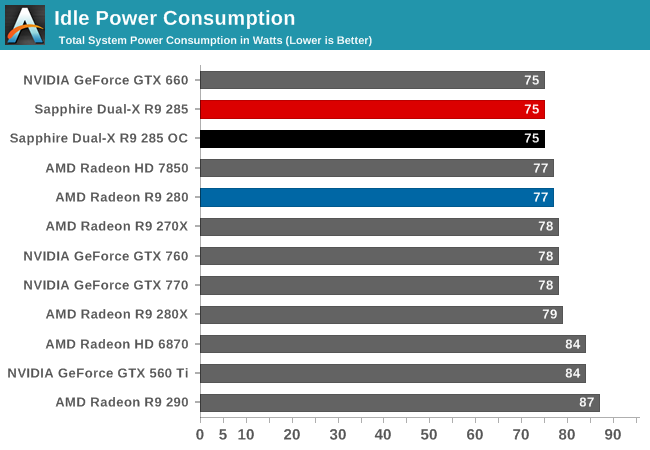
At this point outside of cards that are design deficient in some way or another, idle power is unremarkable. Sapphire’s R9 285 Dual-X puts up with the best, with the 2W gain over the R9 280 likely coming from the reduced VRAM capacity.
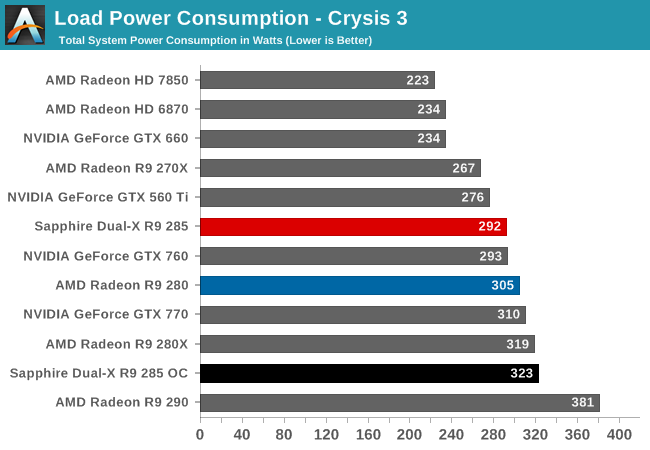
Moving on to load power consumption under Crysis 3 we find that power consumption has been reduced compared to the R9 280, but not remarkably so. Despite the much lower official TBP of 190W versus 250W for the R9 280, the actual difference (for virtually equivalent performance) is 13W of savings at the wall. What this tells us is that despite the PowerTune changes, the R9 285 is sustaining power consumption not all that far removed from the R9 280. In practice the R9 280 was unlikely to be drawing near 250W under a gaming workload, so in this case the 190W value for the R9 285 is not all that far removed from the R9 280. The remaining difference is due to the VRAM reduction and some power efficiency gains in Tonga.
On the other hand power consumption for the Dual-X when using its factory overclock launches ahead. The slight increase in performance under Crysis 3 from this overclock will increase the load on the CPU, but only slightly. The rest comes from the power required to hit and sustain the higher clockspeeds of Sapphire’s overclock. As a result we’re looking at power consumption near the level of an R9 280X.
Meanwhile to make a quick GTX 760 comparison, AMD and NVIDIA are virtually tied. At 292W versus 293W, these cards are drawing virtually identical amounts of power. However the GTX 760 ultimately has the efficiency edge, as it delivers better performance under Crysis 3 than the R9 285 does (though in other games the tables could of course turn).
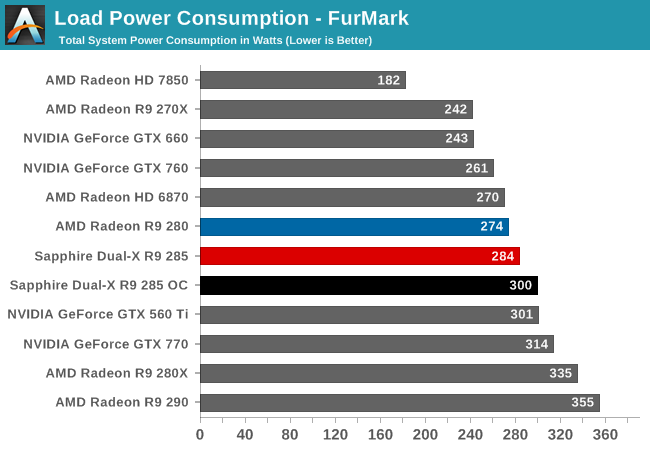
Surprisingly, under Furmark the situation is actually reversed. Instead of the R9 285 beating the R9 280, we’re actually seeing it draw 10W more power despite the lower TBP. Though seemingly nonsensical, in practice this is the newer iteration of PowerTune doing a better job of homing in on the card’s 190W limit. This is a situation the coarse PowerTune implementation on R9 280 would have trouble with, causing it to have to back off on clockspeeds much more severely, and ultimately drawing less power than its limit would truly allow.
The end result is something of a wash. The R9 285 is not drawing significantly more or less power than the R9 280, all the while delivering similar performance. In that context we can say that as a result, power efficiency has not meaningfully changed compared to the R9 280.
Finally to make one more GTX 760 comparison, this illustrates that while AMD can generally beat the GTX 760’s performance, it also comes at the cost of maximum power consumption. At least when faced with a worst case scenario, the R9 285 is going to be drawing about 20W more at the wall.
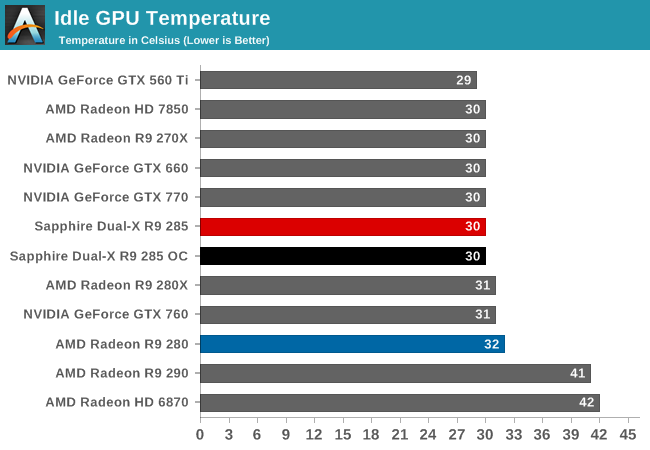
When it comes to idle temperatures, Sapphire’s Dual-X cooler is among the best. 30C at idle is average in the pack only because so many other coolers are as equally able at idle.
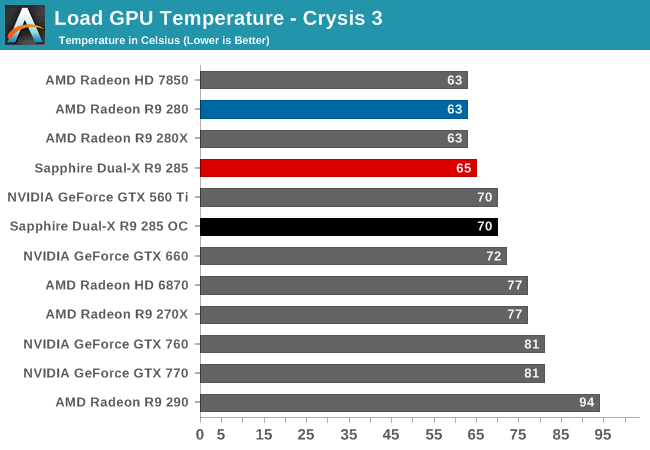
Earlier we mentioned that the Dual-X cooler is probably a bit overpowered for a 190W card, and here we can see why. Under Crysis 3 our card maxes out at a relatively chilly 65C, and even with the factory overclock only pushes to 70C. Sapphire’s card clearly has no problem keeping itself cool.
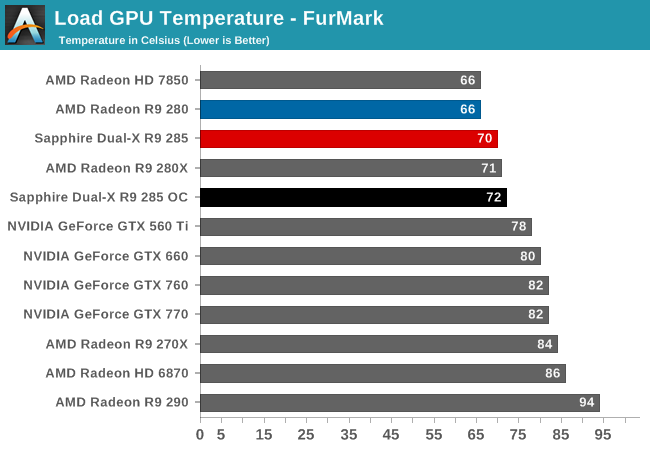
The greater load from FurMark causes temperatures to rise a bit more, but not exceptionally so. Even under this most strenuous of tests we’re topping out at 70C with reference clockspeeds, or 72C with the factory overclock. So long as Sapphire can hit these temperatures without generating too much noise then they’re golden (or blue, as the case may be).
I would also point out at this time that while the R9 285 Dual-X is significantly cooler than the GTX 760, we’re comparing an open air cooler to a blower. All things considered this is exactly the situation where the open air cooler will be the stronger performer. But it comes at the tradeoff of not being able to directly expel all of its waste heat.
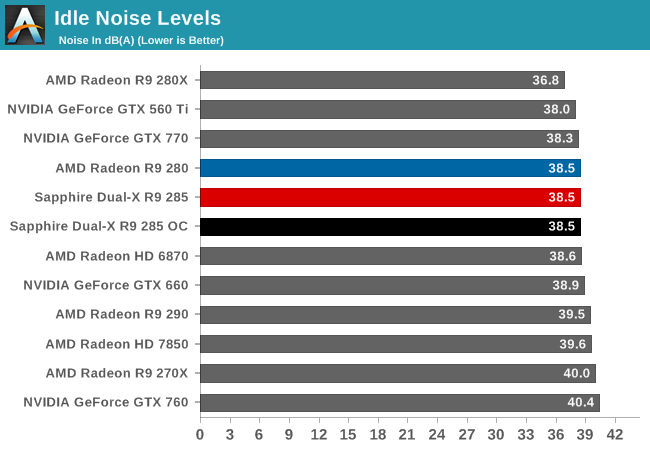
Much like idle temperatures, idle noise levels are looking quite good for Sapphire’s Dual-X cooler. There are a handful of cards that can drop below even 38.5dB, but at this point we’re quickly approaching the overall noise floor.
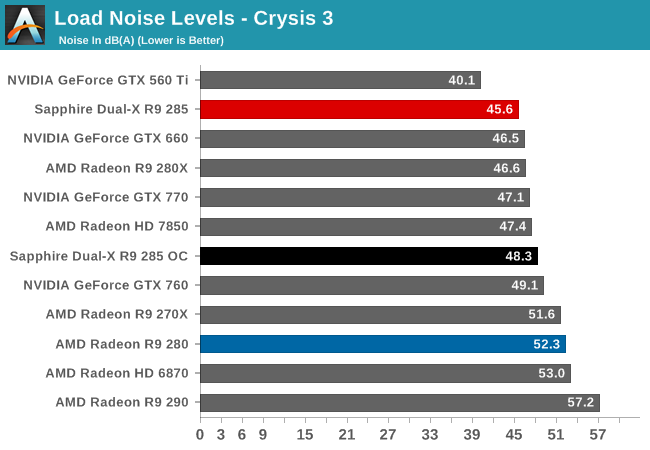
Already doing very well for themselves when it comes to load temperatures, load noise only makes Sapphire’s R9 285 Dual-X look even better. When we underclock it to stock speeds we’re only getting 45.6dB under load, quieter than any Tahiti card, Hawaii card, Pitcairn card, or Kepler card. Only the old GTX 560 Ti (which was impressively overbuilt) can sustain load noises lower than 45.6dB.
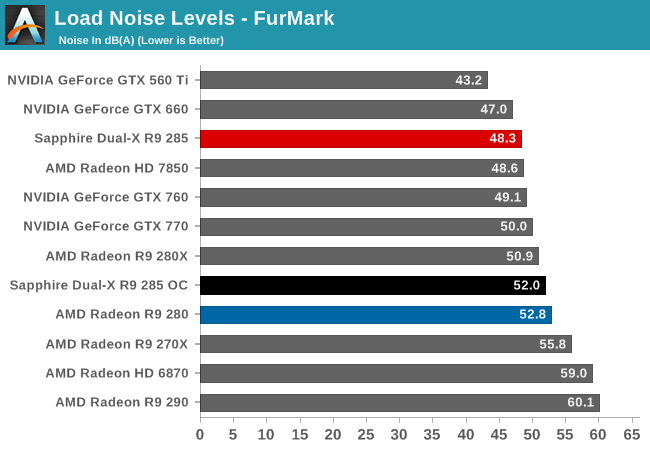
As was the case with temperatures, FurMark also drives up the load noise levels, but not especially so. Even with this additional heat the R9 285 tops out at 48.3dB, staying comfortably under the 50dB level and trailing only the much less powerful GTX 660 and GTX 560 Ti.
Meanwhile when looking at the R9 285 Dual-X with its factory overclock enabled, we unsurprisingly see an increase in noise from the additional heat generated by the overclock. The total penalty for the overclock is 3-4dB, which is a not-insignificant increase in noise. I feel like Sapphire really hit their sweet spot for balancing noise with performance at stock, so the factory overclock deviates from that some. Overall these noise levels are still well within reason, but they’re now middle of the pack instead of near the head of the pack.
Speaking of Sapphire cards, it’s interesting to compare and contrast the R9 285 with our R9 280, which is also a Sapphire card using an identical cooler. Compared to the R9 280, for the R9 285 Sapphire has found a better balance between temperature and noise. The R9 280 could pull off slightly better temperatures, but it was always above 52dB of noise under load as a result.
Ultimately excluding the vender-specific factors, our look at power, temperature, and noise tells us that much like the R9 285’s gaming performance, the R9 285’s power/temp/noise performance is a lateral move for AMD. Performance hasn’t significantly changed and neither has power, which really helps to distill the essence of R9 285 down to its improved GCN 1.2 feature set. Which in this case in particular means features such as the much finer-grained clockspeeds offered by PowerTune.










86 Comments
View All Comments
chizow - Thursday, September 11, 2014 - link
No issues with Boost once you slap a third party cooler and blow away rated TDP, sure :DBut just as I said, AMD's rated specs were bogus, in reality we see that:
1) the 285 is actually slower than the 280 it replaces, even in highly overclocked factory configurations (original point about theoretical performance, debunked)
2) the TDP advantages of the 285 go away, at 190W target TDP AMD trades performance for efficiency, just as I stated. Increasing performance through better cooling results in higher TDP, lower efficiency, to the point it is negligible compared to the 280.
Its obvious AMD wanted the 285 to look good on paper, saying hey look, its only 190W TDP, when in actual shipping configurations (which also make it look better due to factory OCs and 3rd party coolers), it draws power closer to the 250W 280 and barely matches its performance levels.
In the end one has to wonder why AMD bothered. Sure its cheaper for them to make, but this part is a downgrade for anyone who bought a Tahiti-based card in the last 3 years (yes, its nearly 3 years old already!).
bwat47 - Thursday, September 11, 2014 - link
I think the main reason for this card, was to bring things up to par when it comes to features. the 280 (and 280x), were rebadged older high end cards (7950, 7970), and whole these offered great value when it came to raw performance, they are lacking features that the rest of the 200 series will support, such as freesync and trueaudio, and this feature discrepancy was confusing to customers. It makes sense to introduce a new card that brings things up to par when it comes to features. I bet they will release a 285x to replace the 280x as well.chizow - Thursday, September 11, 2014 - link
Marginal features alone aren't enough to justify this card's cost, especially in the case of FreeSync which still isn't out of proof-of-concept phase, and TrueAudio, which is unofficially vaporware status.If AMD released this card last year at Hawaii/Bonaire's launch at this price point OR released it nearly 12 months late now at a *REDUCED* price point, it would make more sense. But releasing it now at a significant premium (+20%, the 280 is selling for $220, the 285 for $260) compared to the nearly 3 year old ASIC it struggles to match makes no sense. There is no progress there, and I think the market will agree there.
If it isn't obvious now that this card can't compete in the market, it will become painfully obvious when Nvidia launches their new high-end Maxwell parts as expected next month. The 980 and 970 will drive down the price on the 780, 290/X and 770, but the real 285 killer will be the 960 which will most likely be priced in this $250-300 range while offering better than 770/280X performance.
Alexvrb - Thursday, September 11, 2014 - link
You just can't admit to being wrong. It maintains boost fine - end of story. That's what I disagreed with you on in the first place. No boost issues - the 290 series had thermal problems. Slapping a different cooler doesn't raise TDP, it just removes obstacles towards reaching that TDP. With an inadequate cooler, you're getting temp-throttled before you ever reach rated TDP. Ask Ryan, he'll set you straight.On top of this, depending on which model 285 you test, some of them eat significantly less power than an equivalent 280. Not all board partners did an equal job. Look at different reviews of different models and you'll see different results. Also, performance is better than I figured it would be, and in most cases it is slightly faster than 280. Which again, I never figured would happen and never claimed.
chizow - Friday, September 12, 2014 - link
Who cares what you disagreed with? The point you took issue was a corollary to the point I was making, which turned out to be true about the theoreticals being misstated and inaccurate when basing any conclusion about the 285 being faster than the 280.As we have seen:
1) The 285 barely reaches parity but in doing so, it requires a significant overclock which forces it to blow past its rated 190W TDP and actually draws closer to the 250W TDP of the 280.
2) It requires a 3rd party cooler similar to the one that was also necessary in keeping the 290/X temps in check in order to achieve its Boost clocks.
As for Ryan setting me straight, lmao, again, his temp tests and subtext already prove me to be correct:
"Note that even under FurMark, our worst case (and generally unrealistic) test, the card only falls by less than 20Mhz to 900MHz sustained."
So it does indeed throttle down to 900MHz even with the cap taken off its 190W rated TDP and a more efficient cooler. *IF* it was limited to a 190W hard TDP target *OR* it was forced to use the stock reference cooler, it is highly likely it would indeed have problems maintaining its Boost, just as I stated. AMD's reference specs trade performance for efficiency, once performance is increased that efficiency is reduced and its TDP increases.
Alexvrb - Friday, September 12, 2014 - link
Look, I get it, you're an Nvidia fanboy. But at least you admitted you were wrong, in your own way, finally. It sustains boost fine. Furmark makes a lot of cards throttle - including Maxwell! Whoops! Should we start saying that Maxwell can't hold boost because it throttles in Furmark? No, because that would be idiotic. I think Maxwell is a great design.However, so is Tonga. Read THG's review of the 285. Not only does it slightly edge out the 280 on average performance, but it uses substantially less power. Like, 40W less. I'm not sure what's Sapphire (the card reviewed here) is doing wrong exactly - the Gigabyte Windforce OC is fairly miserly and has similar clocks.
chizow - Saturday, September 13, 2014 - link
LOL Nvidia fanboy, that's rich coming from the Captain of the AMD Turd-polishing Patrol. :DI didn't admit I was wrong, because my statement to any non-idiot was never dependent on maintaining Boost in the first place, but I am glad to see not only is 285 generally slower than the 280 without significant overclocks, it still has trouble maintaining Boost despite higher TDP than the rated 190W and a better than reference cooler.
You could certainly say Maxwell doesn't hold boost because it throttles in Furmark, but that would prove once and for all you really have no clue what you are talking about since every Nvidia card they introduced since they invented Boost has no problems whatsoever hitting their rated Boost speeds even with the stock reference blower designs. The difference of course, is that Nvidia takes a conservative approach to their Boost ratings that they know all their cards can hit under all conditions, unlike AMD which takes the "good luck/cherry picked" approach (see: R290/290X launch debacle).
And finally about other reviews lol, for every review that says the 285 is better than the 280 in performance and power consumption, there is at least 1 more that echo the sentiments of this one. The 285 barely reaches parity and doesn't consume meaningfully less power in doing so. But keep polishing that turd! This is an ASIC only a true AMD fanboy could love some 3 years after the launch of the chip it is set to replace.
chizow - Saturday, September 13, 2014 - link
Oh and just to prove I can admit when I am wrong, you are right, Maxwell did throttle and fail to meet its Boost speeds for Furmark, but these are clearly artificially imposed driver limitations as Maxwell showed it can easily OC to 1300MHz and beyond:http://www.anandtech.com/show/7764/the-nvidia-gefo...
http://www.anandtech.com/show/7854/nvidia-geforce-...
Regardless, any comparisons of this chip to Maxwell are laughable, Maxwell introduced same performance at nearly 50% reduction in TDP or inversely, nearly double the performance at the same TDP all at a significantly reduced price point on the same process node.
What does Tonga bring us? 95-105% of R9 280's performance at 90% TDP and 120% of the price almost 3 years later? Who would be happy with this level of progress?
Nvidia is set to introduce their performance midrange GM104-based cards next week, do you think ANYONE is going to draw parellels between those cards and Tonga? We already know what Maxwell is capable of and it set the bar extremely high, so if GTX 970 and 980 come anywhere close to those increases in performance and efficiency, this part is going to look even worst than it does now.
Alexvrb - Saturday, September 13, 2014 - link
You were wrong about it being unable to hold boost, you claimed that GCN 1.1 can't hold boost despite clear evidence to the contrary. Silly. Then you were wrong about Maxwell and Furmark - though you kind of admitted you were wrong.Regarding that being a "driver limitation" you can clock a GPU to the moon, and it's fine until it gets a heavy load. However most users won't even know they're being throttled. I had this same discussion YEARS ago with a Pentium 4 guy. You can overclock all you want - when you load it up heavy, it's a whole new game. In that case the user never noticed until I showed him his real clocks while running a game.
Tonga averages a few % higher performance, dumps less heat into your case, and uses less power. Aside from this Sapphire Dual X, most 285 cards seem to use quite a bit less power, run cool and quiet. With all that being said, I think the 280 and 290 series carry a much better value in AMD's lineup. I'm certainly not a fanboy, you're much closer to claiming that title. I've actually used mostly Nvidia cards over the years. I've also used graphics from 3dfx, PowerVR, and various integrated solutions. My favorite cards over the years were a trusty Kyro II and a GeForce 3 vanilla, which was passively cooled until I got ahold of it. Ah those were the days.
chizow - Monday, September 15, 2014 - link
No, I said being a GCN 1.1 part meant it was *more likely* to not meet its Boost targets, thus overstating its theoretical performance relative to the 280. And based on the GCN 1.1 parts we had already seen, this is true, it was MORE LIKELY to not hit its Boost targets due to AMD's ambiguous and non-guaranteed Boost speeds. None of this disproved my original point that the 285's theoreticals were best-case and the 280's were worst-case and as these reviews have shown, the 280 would be faster than the 285 in stock configurations. It took an overclocked part with 3rd party cooling and higher TDP (closer to the 280) for it to reach relative parity with the 280.Tonga BARELY uses any less power and in some cases, uses more, is on par with the part it replaces, and costs MORE than the predecessor part it replaces. What do you think would happen if Nvidia tried to do the same later this week with their new Maxwell parts? It would be a complete and utter disaster.
Stop trying to put lipstick on a pig, if you are indeed as unbiased as you say you are you can admit there is almost no progress at all with this part and it simply isn't worth defending. Yes I favor Nvidia parts but I have used a variety in the past as well including a few highly touted ATI/AMD parts like the 9700pro and 5850. I actually favored 3dfx for a long time until they became uncompetitive and eventually bankrupt, but now I prefer Nvidia because much of their enthusiast/gamer spirit lives on and it shows in their products.